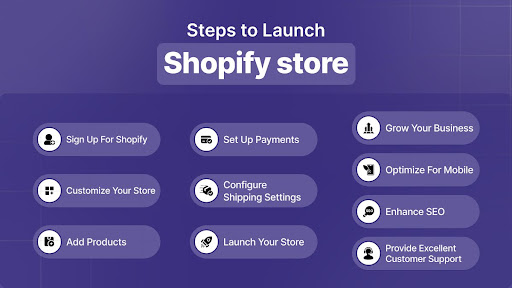To sign up for our daily email newsletter, CLICK HERE

Are you ready to embark on the journey of launching your very own e-commerce business? With the booming online marketplace, there’s never been a better time to start. And what better platform to kickstart your entrepreneurial dreams than Shopify? In this comprehensive guide, we’ll walk you through the process of setting up your first Shopify store, also you can learn how to start a Shopify store.
Understanding Shopify
Before diving into the setup process, let’s take a moment to understand what Shopify is. Shopify is a user-friendly e-commerce platform that allows individuals and businesses to create online stores and sell products.
With its intuitive interface and a plethora of customizable features, Shopify has become the go-to choice for many aspiring entrepreneurs.
Steps to Launch Shopify Store

1. Sign Up for Shopify
The journey begins by signing up for a Shopify account. Head over to the Shopify website and click on the “Get Started” button.
You’ll be prompted to enter some basic information about your business, such as your email address, store name, and desired password.
Once you’ve completed the signup process, you’ll gain access to your Shopify dashboard.
2. Customize Your Store
Now that you’ve created your Shopify account, it’s time to customize your store to reflect your brand identity. Start by choosing a theme from Shopify’s extensive collection of pre-designed templates.
Whether you’re looking for a sleek and modern design or something more whimsical and colorful, Shopify has a theme to suit your needs. You can also go with Shopify Theme development to reflect your brand’s identity and craft your store more appealing to your clients.
Once you’ve selected a theme, you can further customize it by adjusting colors, fonts, and layouts to create a unique look for your store.
3. Add Products
With your eCommerce Shopify store’s design in place, it’s time to start adding products. Navigate to the “Products” section of your Shopify dashboard and click on the “Add product” button
Here, you’ll be prompted to enter details about each product, including its name, description, price, and images.
You can also organize your products into categories to make it easier for customers to browse your store.
4. Set Up Payment
This is another important factor that comes under the Shopify store setup guide. To start accepting payments from customers, you’ll need to set up a payment gateway.
Shopify offers its own payment solution, Shopify Payments, which allows you to accept credit card payments directly through your store. Alternatively, you can integrate third-party payment gateways like PayPal, Stripe, or Apple Pay. Choose the option that best suits your business needs and follow the instructions to set up your payment gateway.
5. Configure Shipping Settings
Once you’ve set up payments, it’s time to configure your shipping settings. Navigate to the “Settings” section of your Shopify dashboard and click on “Shipping.”
Here, you can set up shipping rates based on factors like weight, price, or destination. You can also choose to offer free shipping or set flat-rate shipping fees.
Additionally, Shopify offers integrations with major shipping carriers like UPS, FedEx, and USPS, making it easy to print shipping labels and track packages.
6. Launch Your Store
With everything in place, it’s time to launch your store and share it with the world. Before making your eCommerce Shopify Store live, take some time to review your store and test the checkout process to ensure everything is working smoothly.
Double-check your product listings, payment settings, and shipping rates to make sure they’re accurate. Once you’re satisfied, click on the “Launch” button to make your store live.
7. Grow Your Business
Congratulations, your eCommerce Shopify store is now live! But the journey doesn’t end here. Now it’s time to focus on growing your business and attracting customers
Utilize Shopify’s built-in marketing tools, such as email campaigns, social media integrations, and discount codes, to drive traffic to your store and encourage sales.
Additionally, regularly monitor your store’s performance using Shopify’s analytics tools to track sales, visitor behavior, and other key metrics. Use this data to make informed decisions about marketing strategies, product offerings, and store improvements to continually optimize your store for success.
8. Optimize for Mobile
In today’s mobile-driven world, it’s essential to ensure that your Shopify store is optimized for mobile devices.
With a significant portion of online shopping now taking place on smartphones and tablets, having a mobile-friendly store is crucial for providing a seamless shopping experience to your customers.
Shopify themes are already optimized for mobile, but it’s essential to test your store on various devices to ensure everything looks and functions correctly. Also, you can go with Shopify App development which can help you to optimize your store easily.
9. Enhance SEO
Search engine optimization (SEO) plays a vital role in driving organic traffic to your Shopify store. Shopify SEO services can help improve your visibility in search results and attract more potential customers.
Focus on optimizing your product descriptions, titles, and meta tags with relevant keywords related to your products and target audience. Additionally, regularly update your content, add blog posts, and build backlinks to improve your store’s overall SEO performance.
10. Provide Excellent Customer Support
Last but not least, providing excellent customer support is essential for building trust and loyalty with your customers.
Make it easy for customers to contact you with any questions or concerns they may have about their orders or products.
Consider implementing live chat support, providing detailed FAQs, and responding promptly to customer inquiries via email or social media.
By offering exceptional customer support, you can create a positive shopping experience that keeps customers coming back to your Shopify store time and time again.
Summing Up
Launching your first e-commerce Shopify store may seem like a daunting task, but with the right guidance and resources, it’s entirely achievable.
By following this comprehensive step-by-step guide, you’ll be well-equipped to set up your store with confidence and start your journey as an online entrepreneur. Also you can hire Shopify developers who will help you creating eCommerce Store that reflects your brand’s identity.
Remember to stay patient, stay persistent, and stay passionate about your business. With dedication and hard work, your Shopify store has the potential to become a thriving online venture. Here’s to your success!
Frequently Asked Questions
- Do I need technical skills to set up a Shopify store?
No, you don’t need technical skills to set up a Shopify store. Shopify is designed to be user-friendly, with intuitive tools and interfaces that make it easy for anyone to create and manage an online store.
- Can I customize the look of my Shopify store?
Yes, Shopify allows you to customize the look of your store by choosing from a variety of pre-designed themes and customizing them to fit your brand identity.
You can adjust colors, fonts, layouts, and more to create a unique and professional-looking store.
- How do I add products to my Shopify store?
Adding products to your Shopify store checklist is simple. Just navigate to the “Products” section of your Shopify dashboard and click on the “Add product” button.
From there, you can enter details about each product, including its name, description, price, and images.
- How do I accept payments on my Shopify store?
You can accept payments on your Shopify store by setting up a payment gateway. Shopify offers its own payment solution, Shopify Payments, which allows you to accept credit card payments directly through your store.
Alternatively, you can integrate third-party payment gateways like PayPal, Stripe, or Apple Pay.
- How do I handle shipping on my Shopify store?
Shopify provides tools to help you configure your shipping settings, including setting up shipping rates based on factors like weight, price, or destination. You can also offer free shipping or set flat-rate shipping fees.
Additionally, Shopify integrates with major shipping carriers to help you generate shipping labels and track packages.
About the Author
Himanshu Bayas (Shine Dezign Infonet Pvt Ltd) is a technical content writer with over five years of expertise crafting compelling blogs, articles, and eBooks for the digital realm. Her profound knowledge spans a range of topics, including web hosting, e-commerce, and software-based products. Her insightful articles have enlightened numerous readers, helping them navigate the intricate world of technology with ease. As a writer dedicated to demystifying the intricacies of hosting, e-commerce, and software-based products, Himanshu is your go-to resource for insightful and engaging content that bridges the gap between technology and understanding.